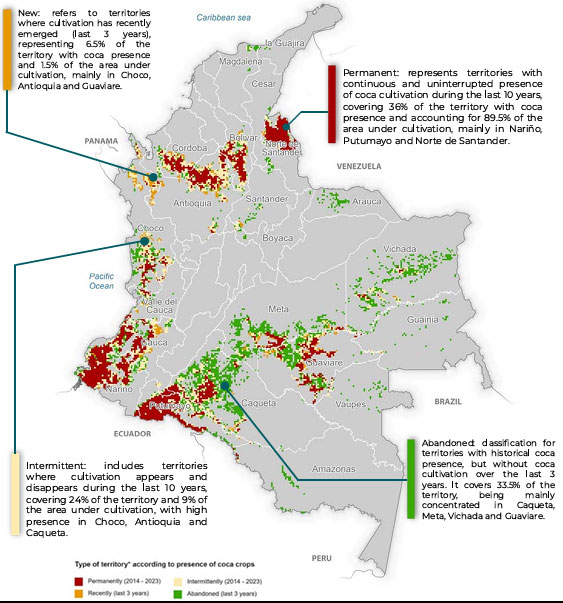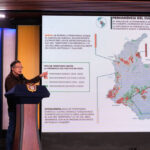Some 4% of the world’s population, some 300 million people, have consumed cocaine in their lives. Colombia produced an estimated 70% of the cocaine consumed over the past year.
In 2023, 25 million people used the illicit drug worldwide, consuming almost 3,708 tons of cocaine that is produced in the Andean region, according to the United Nations Office on Drugs and Crime.
Skip to
Consumption | Production | Trade | Counternarcotics | Downloads
The demand for the drug comes primarily from the United States and Europe, but South America has also grown into a major consumption market.
Cocaine users per country
Skip to
Consumption | Production | Trade | Counternarcotics | Downloads
Almost all cocaine consumed across the globe comes from Colombia, Peru, and to a lesser extent, Bolivia; countries where coca — the crop used for cocaine — is endemic and has been consumed by chewing the leaves or making tea for millennia.
In Colombia, the coca used to produce cocaine is grown mostly in remote parts of the country where the state has been absent and locals have no access to the legal economy.

Because of the lack of state control, land is available for all kinds of illegal or informal activity, including coca cultivation.
In 2023, Colombian coca farmers used approximately an accumulated area of 253,000 hectares to produce the country’s cocaine, according to the UNODC.
At least 130,000 farming families live off coca, producing the crop mainly on a small scale.
These families receive, on average little less than $1,200 a month from selling coca, which sells at a little more than a dollar per kilo, depending on the region.
Coca cultivation
To produce one kilo of cocaine, some 125 kilos of coca are needed, which would cost a local drug lab $137.50. Once the lab has turned the coca leaves first into coca paste, then into coca base, and ultimately into real cocaine, the value will have increased to $2,269.
By the time it gets to the street in, for example, the United States, that kilo of cocaine will provide $60,000 in revenue. In Australia, this could be as much as $235,000.
From coca to cocaine
Cocaine is made in three separate chemical processes; first, the coca is converted into coca paste, then coca base before it becomes real cocaine.
The coca is grown by tens of thousands of peasants in areas that suffer traditional state neglect.
The conversion of coca leaves into coca paste is mainly done by the farmers and to a lesser extent by the drug trafficking organizations. This is because one kilo of cocaine requires approximately 125 kilos of coca leaves.
The dried coca leaves are drenched in gasoline for between 8 to 12 hours to extract the alkaloid or coca base.
Next, the gasoline and the leaves are separated from the alkaloid and water and sulfuric acid are added, combined with pulverized limestone or ammonia.
This is then mixed with acetone and laid to rest. The substance is then filtered with more ammonia and washed with water. The water is evaporated by putting the substance in a slow-burning oven, converting it into something similar to oil.
Once cooled down, this substance has become coca paste, which is dissolved in ether. After another filtering round, chloride acid and more acetone are added. Once this is dry, the cocaine is ready.
Potential cocaine production
The drug labs are generally run by the farmers under the control of local drug trafficking clans, individual guerrilla units, or associates of the international organizations that traffic the drugs to the US, Europe, or the Southern Cone.
Skip to
Consumption | Production | Trade | Counternarcotics | Downloads
Once the coca is processed into cocaine, it is trafficked by local drug traffickers, guerrillas, and nationally operating groups to either one of the country’s two coastlines or one of the country’s borders. A relatively small amount of cocaine is taken to airports.
The cocaine is hidden in trucks or cars if transported over land, or is moved in small boats through dense jungle areas where rivers provide the perfect corridors for almost unhindered illicit trafficking. Along these routes, the drug traffickers intimidate locals and bribe officials to prevent their routes and shipments from being exposed.
Nevertheless, according to Colombia’s Defense Ministry, more than 150 tons of cocaine is seized annually.
The export of cocaine is supervised by transnational crime organizations that do business with foreign crime organizations, particularly Mexican cartels. In a few cases, the Colombian groups have maintained direct routes to foreign markets.
Most of Colombia’s current drug trafficking organizations were formed a decade ago by mid-level commanders of state-aligned paramilitary groups that were active between the 1980s and the early 2000s.
Some of the organizations have their roots in the old Medellin and Cali cartels.
The traffickers bribe security forces, politicians, and judicial authorities to protect their routes and secure the continuity of their business.
Exporting cocaine
When drugs arrive at Colombia’s Caribbean and Pacific coastlines, they are loaded onto small ships or submarines and sailed to transit hubs in the Caribbean and Central America, in some cases already under the supervision of transnational crime groups like the Mexican Sinaloa Cartel.
In the cases of port cities, local crime gangs with close ties to local law enforcement and port authorities oversee the loading of the drugs into containers, often in coordination with international drug trafficking cartels.
Over the past few years, Venezuela has become a major transit hub for cocaine. Hundreds of clandestine airstrips have been found in the country, allegedly used to fly cocaine to Central America or, in fewer cases, to Caribbean islands like the Dominican Republic, Puerto Rico or the Bahamas.
Smaller amounts of drugs are trafficked by air, in risky operations by “drug mules” who either swallow small amounts of drugs or carry pounds or kilos of the illicit substance in their luggage. These drug mules generally work for Colombian organizations with a criminal partner organization in the destination country.
Large quantities of drugs find their way out of the country through the country’s ports, where corruption is rife. One important criminal organization running such an operation is “La Empresa,” a local mafia that’s long been in charge of Colombia’s largest port, Buenaventura. They will have foreign partners on the receiving end, more often than not, these would be cells or gangs linked to large organized crime organizations.
Main cocaine flows (2012-2016)
It is almost impossible to define which form of transport is most effective to get the drugs to their consumption markets in the US, Europe, and South America.
The UNODC has said that — when referring to global trafficking of all drugs — most seizures were made while drugs were transported by air or road, but even though only a few busts have been made in ports or clandestine maritime entry points, the largest drug seizures abroad were made there.
Skip to
Consumption | Production | Trade | Counternarcotics | Downloads
Authorities have been trying to curb coca cultivation by eradicating plants and, until 2015, spraying chemicals over areas where coca fields are most prevalent. All strategies have failed.
According to Colombia’s Defense Ministry, it destroyed more than 20,000 hectares of coca and seized more than 740 tons of cocaine in 2023.
Combating cocaine production is complicated. Many farmers have no alternative and Colombia’s government lacks the capacity to confront the industry that is protected by illegal armed groups with huge financial resources to corrupt state officials.
Furthermore, foreign powers disagree on how to combat the illegal drug trade, which has led to different counternarcotics efforts undoing the work of the other.
While the United Nations and Europe have been pushing crop substitution and rural development, the United States has been pushing for repressive methods like forced eradication and aerial fumigation with chemicals.
Coca eradication
Cocaine seizures in Colombia
Colombia does not have an extensive crop substitution program like Peru, meaning that many farmers can easily replant coca almost immediately after the destruction of their current crops.
Extremely violent resistance from drug traffickers has been complicating crop substitution promoted by the UN and the EU.









